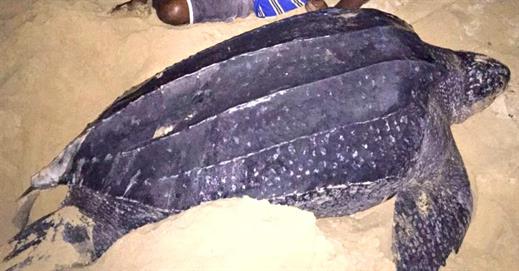


Dermochelys coriacea
| Ecological Descriptors |
||||
| Habitat | Size (cm) | Diet | Behaviour | Sex |
| Pel | to 185 | Jel | I | F |
Description:
Head has a deeply notched upper jaw with 2 cusps. The leatherback is the only sea turtle that lacks a hard shell. Its carapace is large, elongated and flexible with 7 distinct ridges running the length of the animal. Composed of a layer of thin, tough, rubbery skin, strengthened by thousands of tiny bone plates, the carapace does not have scales, except in hatchlings. All flippers are without claws. The carapace , head, neck and flippers are dark grey or black with white or pale spots, while the plastron is whitish to black and marked by 5 ridges. Hatchlings have white blotches on carapace.
It typically grows to 4 to 6 feet (130 - 183 cm), though can be larger and weighs 660 to 1,100 pounds (300 - 500 kg).
It gets its name from its shell which is composed of a layer of thin, tough, rubbery skin, strengthened by thousands of tiny bone plates that makes it look “leathery.”
Ecology
Primarily found in the open ocean, although it predominantly feeds in areas just offshore. They have delicate, scissor-like jaws and feed almost exclusively on jellyfish.
Life Cycle:
In Antigua, the nesting season runs from February to July, with a peak from April-May.
Nest at intervals of 2 to 3 years, though recent research has indicated they can nest every year. Nests between 4 to 7 times per season, with an average of 10 days between nestings. Lays an average of 80 fertilized eggs, the size of billiard balls, and 30 smaller, unfertilized eggs, in each nest. Eggs incubate for about 65 days.
Unlike other species of sea turtles, leatherback females may change nesting beaches, though they tend to stay in the same region.
Head has a deeply notched upper jaw with 2 cusps. The leatherback is the only sea turtle that lacks a hard shell. Its carapace is large, elongated and flexible with 7 distinct ridges running the length of the animal. Composed of a layer of thin, tough, rubbery skin, strengthened by thousands of tiny bone plates, the carapace does not have scales, except in hatchlings. All flippers are without claws. The carapace , head, neck and flippers are dark grey or black with white or pale spots, while the plastron is whitish to black and marked by 5 ridges. Hatchlings have white blotches on carapace.
It typically grows to 4 to 6 feet (130 - 183 cm), though can be larger and weighs 660 to 1,100 pounds (300 - 500 kg).
It gets its name from its shell which is composed of a layer of thin, tough, rubbery skin, strengthened by thousands of tiny bone plates that makes it look “leathery.”
Ecology
Primarily found in the open ocean, although it predominantly feeds in areas just offshore. They have delicate, scissor-like jaws and feed almost exclusively on jellyfish.
Life Cycle:
In Antigua, the nesting season runs from February to July, with a peak from April-May.
Nest at intervals of 2 to 3 years, though recent research has indicated they can nest every year. Nests between 4 to 7 times per season, with an average of 10 days between nestings. Lays an average of 80 fertilized eggs, the size of billiard balls, and 30 smaller, unfertilized eggs, in each nest. Eggs incubate for about 65 days.
Unlike other species of sea turtles, leatherback females may change nesting beaches, though they tend to stay in the same region.
(C) John Soward





389
388
LeatherbackTurtle
LeatherbackTurtle





